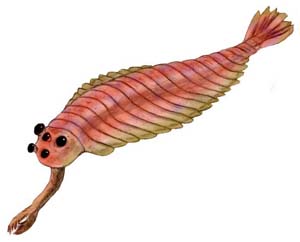A mysterious animal
The Opabinia regalis is a mysterious animal lived in the Middle Cambrian (about 505 million years ago). His remains have been found in Canada, in the famous marine field known as the Burgess shale.
 The appearance of this animal was really bizarre: the head, in particular, was equipped with a long tubular member, flexible and segmented, the end of which was present a sort of toothed "chela". Perhaps this "tube", similar to that of a vacuum cleaner, was equipped with a central channel filled with liquid, which ensured rigidity and flexibility at the same time. On the head there were five eyes: four of these were symmetrical and placed on stalks, while the fifth eye was positioned at the center of the head.
The appearance of this animal was really bizarre: the head, in particular, was equipped with a long tubular member, flexible and segmented, the end of which was present a sort of toothed "chela". Perhaps this "tube", similar to that of a vacuum cleaner, was equipped with a central channel filled with liquid, which ensured rigidity and flexibility at the same time. On the head there were five eyes: four of these were symmetrical and placed on stalks, while the fifth eye was positioned at the center of the head.
The intestine was formed from a single tubular cavity that ran through the entire animal in a central position, but near the head of the cavity and then fold it curved to form a U-facing mouth. It is interesting to note that the length of the strange "tube" was exactly what needed to reach the mouth, probably the Opabinia was using the "claw" to grab their prey, which were then brought to the mouth by a tube. The body is formed from about fifteen segments, each of which was equipped with side lobes enlarged, facing down and the outside and partially overlapping. All lobes, with the exception of the first, leading on the dorsal surface a gill-shaped dorsal fin with so much of lamellae. The last three segments of the body are upturned and outside, to form a tail which probably served to direct the animal.
Dell'Opabinia were found just over ten specimens, all in the field of Burgess. The bizarre appearance of the animal has always been a big problem for his classification, and to this day scholars are very uncertain as to the possible identity of Opabinia.
The first to describe the animal was Charles Doolittle Walcott, who in 1912 presented a publication in which illustrated the Opabinia as a primitive arthropod, Walcott thought that the long segmented body were a legacy of his descent from an ancestor annelid. The absence of any appendix biramata was explained simply by the alleged poor preservation of the specimens.
G. Evelyn Hutchinson, for his part, rebuilt the Opabinia as a anostracod, complete with a swimming upside down as current forms: in its reconstruction, the side flaps turned into long blade-like appendages.
A. M. Simonetta, however, preferred to recognize in the Opabinia an arthropod, complete with appendices biramate (only suppositories) and frontal appendages "unified" to form the pipe with the claw. The five eyes, however, became two: a pair is "transformed" into a pair of short appendices, as well as a draft on the carapace.
In 1974 he was Harry Whittington to tackle the problem of Opabinia: the result was that this animal could not be included in any known phylum, and that its unique characteristics isolated it from any other known animal. In recent years, however, the Opabinia seems to have found a proper classification: Dinocarida would be part of a mysterious group of animals of uncertain systematic position, but perhaps distantly related to arthropods. The most famous representative of this group is Anomalocaris.
Scientific classification
Domain Eukaryota
Kingdom Animalia
Phylum Lobopodia
Class Dinocarida
Order Radiodonta
Genus Opabinia
Specie O. regalis
Binomial nomenclature
Opabinia regalis
Walcott, 1912

 The appearance of this animal was really bizarre: the head, in particular, was equipped with a long tubular member, flexible and segmented, the end of which was present a sort of toothed "chela".
The appearance of this animal was really bizarre: the head, in particular, was equipped with a long tubular member, flexible and segmented, the end of which was present a sort of toothed "chela". 
